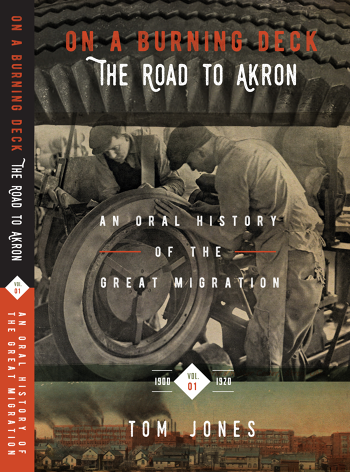 On a Burning Deck. The Road to Akron. An Oral History of the Great Migration vol. 1. & On a Burning Deck: Return to Akron. By Tom Jones. (2017. Pp. 298. $18.95. Paperback. CreateSpace Independent Publishing Platform: http://www.onaburningdeck.com/) ISBN: 978-1-5440-2537-7 & 978-1545565766.
On a Burning Deck. The Road to Akron. An Oral History of the Great Migration vol. 1. & On a Burning Deck: Return to Akron. By Tom Jones. (2017. Pp. 298. $18.95. Paperback. CreateSpace Independent Publishing Platform: http://www.onaburningdeck.com/) ISBN: 978-1-5440-2537-7 & 978-1545565766.
Akron, Ohio native Tom Jones presents a fascinating story of the early twentieth century Great Migration in his book On a Burning Deck. The Road to Akron. An Oral History of the Great Migration vol. 1. Jones asserts that of the hundreds of thousands of people who made the trek from Appalachia in order to work in the rubber industry in Akron, his grandfather, Haskell Jones, was the only migrant to leave a lasting record of his journey.
Jones begins his book with a brief historiography of the subject, describing a gap in scholarship in which he states that there is no body of historical literature that documents how the migrants impacted the culture, history, and politics of Akron. There are no diaries, letters, notes, or recordings to explain who these people were or how they lived, leaving their individual voices otherwise lost to history.
That is, lost except for the story told within the pages of The Road to Akron. His journey for this series began with a burning question: “Who Were the “Hillbillies” That Built Modern Industrial Ohio?”
Jones chronicles over 50 hours of unpublished oral histories, alongside hundreds of rare photographs, which he supplements with newspapers, letters, and contemporary reports, in order to give the only thoroughly documented first-hand account of a white southern family who made the migration north to Akron.
Part one of The Road to Akron details Haskell and his wife Florence’s life in early 1900s Kentucky, navigating through topics such as race relations, public education, and tuberculosis. Jones uses an oral history format, putting his grandparents’ own words directly on to the page, while also expanding upon subjects using meticulously researched narratives.
 Part two, Return to Akron, begins with a short history of Akron from the mid-1800s to the early 1900s, recounting how it became a booming manufacturing and trade center and “the rubber city of the world.” Haskell describes his life in Akron while also reminiscing about World War I, prohibition, the Spanish flu, and factory conditions.
Part two, Return to Akron, begins with a short history of Akron from the mid-1800s to the early 1900s, recounting how it became a booming manufacturing and trade center and “the rubber city of the world.” Haskell describes his life in Akron while also reminiscing about World War I, prohibition, the Spanish flu, and factory conditions.
The overall story of migration from Eastern Kentucky to points north for work necessary for survival is a prevalent one during the early 20th century. Many Kentucky family branches were scattered to the north – some with continued contact, some without any future contact, or family connections faded away over the generations. Not only can this book give us a glimpse into the migration experience, but for those whose ancestors went to Akron, some of the contacts mentioned in these books could appear in the stories.
The Road to Akron is a rich oral history given by an interesting and lively man. The history contained within this book is thoroughly researched and referenced and includes a biography as well as notes for each chapter.
Anyone interested in 20th century Kentucky or Ohio, industrial history, oral history, or genealogy should dig into this series. As historical context is very important to understanding our ancestors, this type of book is a must read for the descendants of migration.
